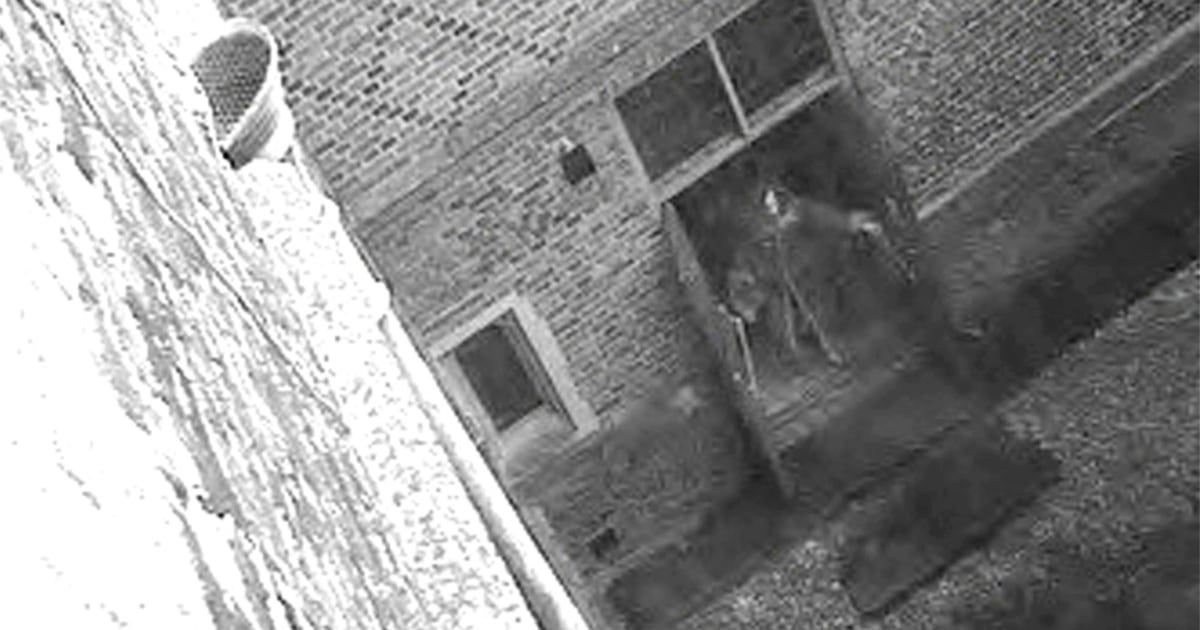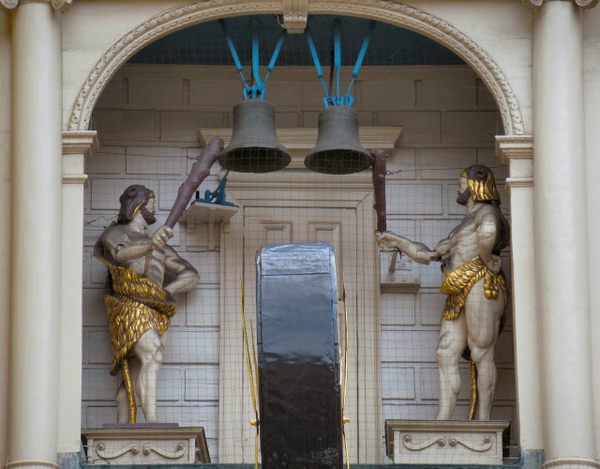
Stephen Arnell Investigates
Hampton Court Palace Ghost
December AD 2003: Closed-circuit security cameras at Hampton Court Palace detect a strange ghostly figure, “We’re baffled — it’s not a joke, we haven’t manufactured it, we genuinely don’t know who it is or what it is.” In the image, a robed figure (which could be of either sex), steps from the shadowy doorway, its arm reaching out for the door handle.
“It was incredibly spooky because the face just didn’t look human. My first reaction was that someone was having a laugh, so I asked my colleagues to take a look. We spoke to our costumed guides, but they don’t own a costume like that worn by the figure. It is actually quite unnerving,” said James Faukes, one of the palace security guards.
Who could it be?
King Henry VIII’s third wife, Jane Seymour, died giving birth to the future Edward VI; her ghost supposedly walks the cobbled courtyards carrying a candle. Edward’s nurse Sibell Penn was buried in the palace grounds in 1562; construction work disturbed her tomb and a weird noise began to be heard nearby. Workmen uncovered a small forgotten room boasting an antique spinning wheel, one which Penn might well have used. Henry’s fifth bride, Catherine Howard was condemned for adultery with courtier Thomas Culpeper, then incarcerated at the Palace before her beheading at the Tower of London. She has reportedly been seen floating down the galleries emitting awful shrieks in anticipation of her eventual fate.
Culpepper’s execution:
There are many other sites associated with the wives of Henry VIII, the paranoid, unpredictable, hot-tempered, homicidal and rancidly smelly Tudor monarch in middle age (due to a seeping ulcer from a jousting wound, obesity, the clap, and a lack of basic hygiene).
I won’t explore them all, but will note some of particular interest, to me at least.
Thomas Cromwell’s botched execution
It’s odd to note, that Henry’s chief minister Thomas Cromwell, who died in a botched execution for treason at the Tower in 1540, has never reappeared as a spectre, especially since the king later accused his ministers of bringing about Cromwell's downfall by "pretexts" and "false accusations".
Just months after Cromwell’s death, the French envoy reported Henry, “sometimes even reproaches [his ministers] with Cromwell’s death, saying that, upon light pretexts, by false accusations, they made him put to death the most faithful servant he had ever had”.
The ghost of Sir Nicholas Hervey of Thurleigh?
Incidentally, I live not too far from the Bedfordshire town of Ampthill, where Henry’s first wife Catherine of Aragon spent some years after her marriage ended. She does not haunt the grounds of the now demolished castle where she lived, but a knight who was loyal to her is rumoured to.
However, this may actually be Sir Nicholas Hervey of Thurleigh, sent to Ampthill Castle to obtain the annulment from Catherine. An ill man, his talk with Catherine was wearying and to no avail, and after leaving the Queen’s room he suffered heart failure or a fatal attack of the ‘sweating disease’. His remains are in the graveyard of nearby Ampthill Church, commemorated by a brass of a Knight in Full Shining Armour in the North aisle. Could the ghost be the spectre of Sir Nicholas – or perhaps a 16th century urban legend?
Also, if you’re in the area, check out nearby slighted 17th mansion Houghton House, where visitors have reported seeing the ghost of a little waif standing in the doorway, and also a spooky horse drawn coach. I have been to the atmospheric site many times, but have yet to see any spectral goings-on.

Katherine returns to Ampthill:

Heads up - Catherine's back at Ampthill boozer: https://www.bedfordtoday.co.uk/heritage-and-retro/heritage/heads-up-catherines-back-at-ampthill-boozer-4711977
Ghost Round Up
Here’s a round up of where you may find the shades of The Six Wives, in order of marriage to Henry the bounder:
Katherine of Aragon (1485-1536)

Katherine can be seen at Kimbolton Castle, where she died on January 7th, 1536 after years of misery, barred from contact with her only child, Mary. Her phantom can apparently be seen on two floors of the castle, but walking a route that would have only existed in her lifetime, her top half on the upper floor, bottom on the lower.
Anne Boleyn (c.1500-1536)

Many locations are associated with post-life visitations by the most famous of Henry’s wives, including:
Hever Castle, Kent, Anne Boleyn’s family home, and the location of her courting done by the relentless Henry. She is said to return every Christmas Eve to perambulate the gardens.

Blickling Hall, Norfolk, most likely where Anne was born. Her ghost is said to return in a carriage pulled by a headless horseman with headless horses - Anne is seen holding her head on her lap. Her dad, the unlikeable daughter-pimping Thomas Boleyn, was cursed to be chased by demons around the grounds for a thousand years. You therefore have until 2539 AD to see him there, scampering along, being whipped by imps and howling in pain. Serves him right, if you ask me.

Anne is also said to appear at the window of the Dean’s Cloister at Windsor Castle. Her daughter Elizabeth I also haunts Windsor. So she has company. Although Henry does as well (see later) - probably not so welcome.

The Tower of London: Seen mainly in the White Tower and on Tower Green, where Anne was executed by a single stroke from a French headsman. In 1817, a guard saw her shade and apparently suffered a fatal heart attack; in 1864 she was witnessed by guards outside the Queen’s House. Also abides less frequently in the Chapel of St Peter ad Vincula, her burial spot.

Salle Church, Norfolk, it’s rumoured Anne’s body was moved here in secret. Boleyn burials, such as Anne’s grandparents, are at the church, hence the theory. Anne appears there annually on May 19th, the anniversary of her execution.
Jane Seymour (c.1508-1537)

Jane Seymour’s main haunts are the Clock Court and the Silver Stick Gallery and its staircase, near the rooms that she gave birth and died in. It has been said she is begging the forgiveness of Anne Boleyn, while others claim she is searching for her son, only 12 days old when she died.
Anne of Cleves (1515-1557)

Lucky Anne of Cleves does not seem to have a ghost. Once divorced, she was gifted Hever Castle (Anne Boleyn’s old family home), and a generous pension. The haunted Anne of Cleve’s House in Lewes has no proven association with her.
Catherine Howard (c.1521-1540)

As said, her ghost is known to both visitors and Hampton Court Palace staff alike, where Catherine stalks the ‘Haunted Gallery’. In the 1990s, two women on separate occasions fainted in precisely the spot her screeching apparition appears.
Catherine Parr (1512-1548)

The staff at Sudeley Castle affectionately call her wraith ‘Katie’. Catherine has been seen strolling through the gardens or admiring them from a window, donned in Tudor green and smelling pleasantly of fresh apples. It is deduced that she is looking for her daughter and only child, Mary, who was just a few days old when Catherine died from the birth in 1548. Her mother's wealth was left entirely to her soon-to-be executed father and later confiscated by the Crown, leaving her a penniless orphan consigned to the neglectful care of Katherine Willoughby, Duchess of Suffolk. As no claim was ever made on her father's remaining estate, the conclusion is she did not live past two years of age.
Does Henry VIII himself haunt anywhere?
Windsor Castle, The Tower of London and Hampton Court have all been associated with the king’s phantom, but nothing of particular record. Maybe his deeply unpleasant stench lingers, though.
I can only assume he’s probably residing somewhere with a rather hot climate.
Viewing highlights
November 2024 - Wolf Hall - The Mirror and the Light Historical Television Series Premiere
Wolf Hall: The Mirror and the Light historical drama television series premiered on BBC One and BBC iPlayer on November 10, 2024. The series is a second adaptation by Peter Straughan of the Wolf Hall novels by Hilary Mantel. The Mirror & the Light is the final novel in the trilogy.
Wolf Hall Cast
- Mark Rylance as Thomas Cromwell
- Damian Lewis as Henry VIII
- Kate Phillips as Jane Seymour
- Anton Lesser as Thomas More
- Jonathan Pryce as Cardinal Wolsey
- Thomas Brodie-Sangster as Rafe Sadler
- Timothy Spall as Duke of Norfolk
- Harriet Walter as Lady Margaret Pole
- Joss Porter as Richard Cromwell
In The Tudors (2007-2010), the king is haunted by his deceased wives:
And in Monarch (2000/2024) an aged Henry VIII (T.P McKenna) also experiences his very own dark night of the soul continues when the ghosts of his wives return to haunt him (all played by Jean Marsh).
A miscast Ray Winstone as Henry:
And not forgetting poor Lady Margaret Pole, Countess of Salisbury - the ‘Last of the Plantagenets’

On the morning of 27 May 1541, 67-year-old Lady Margaret Pole, Countess of Salisbury was led to Tower Green for her execution for supposed treason. Witnesses expected her to speak a few words before laying her head upon the block. Instead, the countess told the headsman she was not going to kneel and he would have to do it where she stood. Guards grabbed her and forced her head to the block as she struggled.
The executioner was so perturbed by events that instead of striking her neck with the axe, he caught her shoulder. White-haired Lady Pole, with blood pouring from her wound, rose up and attempted to run off, whilst the executioner pursued her round the scaffold, eventually dispatching the countess with no less than eleven wild blows. On the anniversary night of Pole’s execution, her apparition can be seen desperately running around Tower Green, blood streaming from her wounds, eternally pursued by the phantom headsman. A ‘twofer’, if you will.
The following poem was found carved on the wall of Margaret's cell in the Tower:
"For traitors on the block should die; I am no traitor, no, not I!
My faithfulness stands fast and so, Towards the block I shall not go!
Nor make one step, as you shall see; Christ in Thy Mercy, save Thou me!"
Incidentally, although Margaret was one of the last well-known Plantagenets (who ruled England from 1154 to 1485), the line continues to this day, with the rightful (to some) claimant to the British throne, Simon Abney-Hastings, 15th Earl of Loudoun. In 2004, C4 in the UK broadcast this documentary about his father Michael Abney-Hastings, 14th Earl of Loudoun.
Stephen Arnell’s novel THE GREAT ONE is available to buy on Amazon Kindle:
https://www.amazon.co.uk/Great-One-Secret-Memoirs-Pompey-ebook/dp/B0BNLTB2G7
Opening chapters:



















